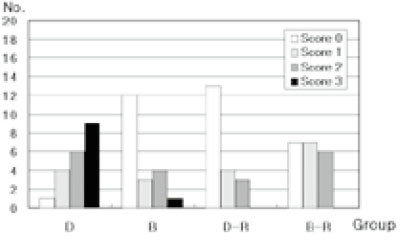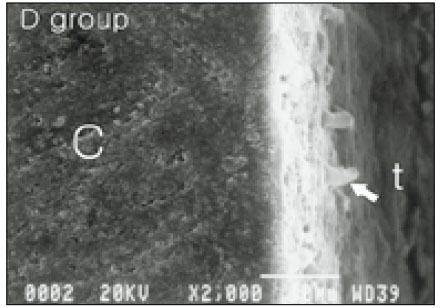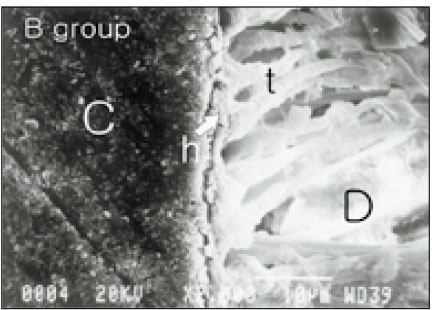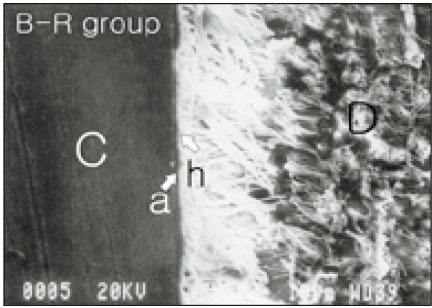J Korean Acad Conserv Dent.
2003 Jan;28(1):11-22. 10.5395/JKACD.2003.28.1.011.
Effect of a rewetting agent on dentin adhesion
- Affiliations
-
- 1Department of Conservative Dentistry, College of Dentistry, Chosun University, Korea. ygcho@mail.chosun.ac.kr
- KMID: 2117426
- DOI: http://doi.org/10.5395/JKACD.2003.28.1.011
Abstract
- This study compared the dentin adhesion to composite resin according to air-dry, blot dry, application of rewetting agent on air-dry or blot dry dentin surface by microleakag test and SEM observation. For microleakage test, class V cavity preparations with dentinal margins were prepared on both buccal and lingual surfaces of 40 extracted human molars. For SEM observation, occlusal dentin of 20 extracted human molars were exposed. After etched the dentin, prepared teeth were randomly divided into four groups; D group: air dry for 10-15 sec., B group: blot dry with moist cotton pellet, D-R group: air dry and rewet with Aqua-Prep F for 20 sec., B-R group: blot dry and rewet with Aqua-Prep F for 20 sec. Treated cavities and surfaces were filled or constructed using One-Step adhesives and Aelitefil composite resins. Specimens were stored in distilled water for 24 hours. For microleakage test, the specimens were thermocycled and soaked into 2% methylene blue. The specimens were sectioned longitudinally and evaluated for microleakage under steromicroscope. The data were statistically analysed by Kruskal-Wallis Test, Mann-Whitney and Wilcoxon signed ranked tests. For SEM observation, the specimens were bisectioned mesiodiatally. After decalcified and deproteinized, specimens were observed under SEM. The results of this study were as follows; 1. The microleakges on dentinal margin were the highest in D group compared with B group, D-R group, and B-R group(p<0.05). But there was no significant difference between B group, D-R group and B-R group. 2. D group showed gap and a few resin tags between dentin and composite resin. 3. B group, D-R group, and B-R groups showed close adaptation between dentin and composite resin. It showed that resin rags in B group were numerous and long, in D-R group were few and short, in B-R group were numerous and short or long. 4. Adhesive layer showed in D-R group (10 microm) and B-R group (3 microm) In conclusion, use of rewetting agent to dry dentin was efficient to dentin adhesion, also it did not provide reverse effect on blot dry dentin.
Keyword
MeSH Terms
Figure
Cited by 1 articles
-
Effect of rewetting agent on dentinal microtensile bond strength
Hee-Young Kang, Young-Gon Cho, Jong-Uk Kim, Byung-Cheul Park, Sang-Hoon Yoo, Cheul-Hee Jin, Hee-Young Choi, Young-Jae Ki
J Korean Acad Conserv Dent. 2004;29(2):153-161. doi: 10.5395/JKACD.2004.29.2.153.
Reference
-
1. Applequist EA, Meiers JC. Effect of bulk insertion, prepolymerized resin composite restorations. Quintessence Int. 1996. 27:253–258.2. Mehl A, Hickel R, Kunzelmann KH. Physical properties and gap formation of light-cured comlpposites with and without sofstart polymerization. J Dent. 1997. 25:321–330.
Article3. Taylor MJ, Lynch E. Microleakage: Review. J Dent. 1992. 20:3–10.4. Prati C, Tao L, Simpson M. Permeability and microleakage of class II resin composite resin restorations. J Dent. 1994. 22:49–56.5. Bauer JF, Henson JL. Microleakage: a measure of the performance of direct filling materials. Oper Dent. 1984. 9:2–9.6. Kidd EAM. Microleakage: a review. J Dent. 1976. 4:199–205.7. Santini A, Plasschaert AJM, Mitchell S. Marginal leakage of filled dentin adhesives used with wet and dry bonding techniques. Am J Dent. 2000. 13(2):93–97.8. Amaral CM, Hara AT, Pimenta LAF, Rodrigues Jr. AL : Microleakage of hydrophillic systems in class V composite restorations. Am J Dent. 2001. 14(1):31–34.9. Nakajima M, Sano H, Urabe I. Bond strength of single bottle dentin adhesives to caries-affected dentin. Oper Dent. 2000. 25:2–10.10. Nakabayashi N, Kojima K, Masuhara E. The promotion of adhesion by infiltratrion of monomers into tooth substrates. J Biomed Mater Res. 1982. 16:265–273.
Article11. Pioch T, Staehle HJ, Schneider H, Duschner H, Dörfer CE. Effect of intrapulpal pressure simulation in vitro on shear bond strenghts and hybrid layer formation. Am J Dent. 2001. 14(5):319–323.12. Gallo JR, Henderson M, Burgess JO. Shear bond strength to moist and dry dentin of four dentin bonding systems. Am J Dent. 2000. 13(5):267–270.13. Tay FR, Gwinnett AJ, Wei SHY. Micromorphological spectrum from overdrying to overwetting acid-conditioned dentin in water-free, acetone-based, single-bottle primer-adhesives. Dent Mater. 1996. 12:236–244.
Article14. Kanca J. Effect of drying on bonding strength. J Dent Res. 1991. 70:304. (Abstract 1029).15. Gwinnett AJ. Moist versus dry dentin: its effect on shear bond strength. Am J Dent. 1992. 5:127–129.16. Gwinnett AJ. Dentin bond strength after air drying and rewetting. Am J Dent. 1994. 7(3):144–148.17. Gwinnett AJ, Kanca J. Micromorphology of the bonded dentin interface and its relationship to bond strength. Am J Dent. 1992. 5:73–77.18. Kanca J. Resin bonding to wet substrate. I. bonding to dentin. Quintessence Int. 1992. 23(1):39–41.19. Kanca J. Effect of resin primer solvents and surface wetness on resin composite bond strength to dentin. Am J Dent. 1992. 5:213–215.20. Kanca J. Wet bonding: Effect of drying time and distance. Am J Dent. 1996. 9:273–276.21. Kanca J, Sandrik J. Bonding to dentin, clues to the mechanism of adhesion. Am J Dent. 1998. 11:154–159.22. Perdigao J, Swift EJ, Cloe BC. Effects of etchants, surface moisture, and resin composite on dentin bond strength. Am J Dent. 1993. 6:61–64.23. Perdigão J, Swift EJ, Heymann HO, Malek MA. Effect of a re-wetting agent on the performance of acetone-based dentin adhesives. Am J Dent. 1998. 11:207–213.24. Miears JR, Charlton DG, Hermesch CB. Effect of dentin moisture and storage time on resin bonding. Am J Dent. 1995. 8:80–82.25. Perdigao J, Geraldeli S, Carmo ARP, Dutra HR. In vivo influence of residual moisture on microtensile bond strength of one-bottle adhesives. J Esthet Restor Dent. 2002. 14(1):31–38.
Article26. Tay FR, Gwinnett AJ, Wei SHY. Micromorphological spectrum of acid conditioned dentin following the application of a water-based adhesive. Dent Mater. 1998. 14:329–338.
Article27. Perdigao J, Van Meerbeek B, Lopes MM, Ambrose WW. The effect of a re-wetting agent on dentin bonding. Dent Mater. 1999. 15:282–295.
Article28. Saunders WP, Saunders EM. Microleakage of bonding agents with wet versus dry bonding techniques. Am J Dent. 1996. 9:34–36.29. Santini A, Mitchell S. Effect of wet and dry bonding techniques on marginal leakage. Am J Dent. 1998. 11:219–224.30. Santini A, Mitchell S. Microleakage of composite restorations bonded with three new bonding agents. J Esthet Dent. 1998. 10:296–304.
Article31. Ritter AV. Re-wetting agents for dentin bonding. J Esthet Restor Dent. 2001. 13(6):387–395.
Article32. Swift EJ. Resin desensitizers. J Esthet Dent. 1999. 11(6):289–290.33. Gwinnett AJ. Chemically conditioned dentin: a comparison of conventional and environmental scanning electron microscopy findings. Dent Mater. 1994. 10:150–155.
Article34. Peschke A, Blunck U, Roulet JF. Influence of incorrect application of a water-based adhesive system on the marginal adaptation of class V restorations. Am J Dent. 2000. 13(5):239–244.35. Tay FR, Gwinnett AJ, Wei SHY. Ultrastructure of the resin-dentin interface following reversible and irreversible re-wetting. Am J Dent. 1997. 10:77–82.36. Ritter AV, Heymann HO, Swift EJ Jr, Perdigao J, Rosa BT. Effects of different re-wetting techniques on dentin shear bond strengths. J Esthet Dent. 2000. 12(2):85–96.
Article37. Van Meerbeek B, Peumans M, Verschueren M. Clinical status of ten dentin adhesive systems. J Dent Res. 1994. 73:1690–1702.
Article38. Alani AH, Toh CG. Detection of microleakage around dental restoration: a review. Oper Dent. 1997. 22:173–185.39. Dietschi D, De Siebenthal G, Neveu-Rosenstand L. Influence of the restorative technique and new adhesives on the dentin marginal seal and adaptation of resin composite class II restoration: an in vitro evaluation. Quintessence Int. 1995. 26:717–727.40. Mangum FI, Berry EA, DeSchepper E. Microleakage of incremental versus compression matrix bulk filling of cervical resin composite restorations. Gen Dent. 1994. 42:304–308.41. Rossomando JJ, Wendt SLJ. Thermocycling and dwell times in microleakage evaluation for bonded restorations. Dent Mater. 1995. 11:47–51.
Article42. Gladys S, Van Meerbeek B, Lambrechets P, Vanherle G. Microleakage of adhesive restorative materials. Am J Dent. 2001. 14(3):170–176.43. Setien VJ, Cobb D, Denehy GE, Vargas M. Cavity preparation devices: Effect on microleakage of class V resin-based composite restorations. Am J Dent. 2001. 14(3):157–162.44. Barnes DM, McDonald NJ, Thompson VP, et al. Microleakage in facial and lingual Class 5 composite restorations: A comparison. Oper Dent. 1994. 19:133–137.45. Maciel KT, Carvalho RM, Ringle RD, Preston CD, Russell CM, Pashley DH. The effects of acetone, ethanol, HEMA, and air on the stiffness of human decalcified dentin matrix. J Dent Res. 1996. 75:1851–1858.
Article46. Santini A. Microleakage of resin-based composite restorations using different solvent-based bonding agents and methods of drying acid-etched dentin. Am J Dent. 1999. 12(4):194–200.47. Nakajima M, Kanemura N, Pereira PNR, Tagami J, Pashley DH. Comparative microtensile bond strength and SEM analysis of bonding to wet and dry dentin. Am J Dent. 2000. 13(6):324–328.48. Inokoshi S, Hosoda H, Harnirattisai C. Interfacial structure between dentin and seven dentin bonding systems revealed using argon ion beam etching. Oper Dent. 1993. 18:8–16.49. Sugizaki J. The effects of various primers on dentin adhesion of resin composites. SEM and TEM observation of the resin impregnated layer and adhesion promoting effect of the primer. Jpn J Conserv Dent. 1991. 34:228–265.50. Watanabe I, Takarada K, Nakabayashi N. Adhesion of 4-META/MMA-TBB resin to dentin pretreated with phosphoric acid. J Jpn Dent Mater. 1997. 10:671–677.51. Xu J, Stangel I, Butler IS, Gilson DFR. An FT-Raman spectroscopic investigation of dentin and collagen surface modified by 2-hydroxyethyl methacrylate. J Dent Res. 1997. 76:596–601.
Article52. Di Renzo M, Ellis T, Domingue A, Bertrand L, Sacher E, Stangel I. Chemical reactions between dentin and bonding agents. J Adhes Dent. 1994. 47:115–121.
Article53. Harashima I, Hirasawa T. Adsorption of 2-hydroxyethyl methacrylate on dentin from aqueous solution. Dent Mater J. 1990. 9:36–46.
Article54. Munksgaard EC, Asmussen E. Bond strength between dentin and restorative resins mediated by mixtures of HEMA and glutaraldehyde. J Dent Res. 1984. 63:1087–1089.
Article55. Nakabayashi N, Watanae A, Gendusa NJ. Dentin adhesion of modified 4-META/MMA-TBB resin : function of HEMA. Dent Mater. 1992. 8:259–264.56. Suzuke K, Takahashi M, Nakai H. Treatment of dentin by aqueous solution of amino acid derivatives : HEMA. J Adhes Dent. 1990. 8:43–51.57. Itoh K, Wakumoto S. Momentary pretreatment by 35% HEMA solution combined with five marketed bonding agents. Dent Mater J. 1987. 6:28–31.58. Pilo R, Cardash HS, Oz-Ari B, Ben-Amar A. Effect of preliminary treatment of the dentin surface on the shear bond strength of resin composite to dentin. Oper Dent. 2001. 26:569–575.
- Full Text Links
- Actions
-
Cited
- CITED
-
- Close
- Share
- Similar articles
-
- Effect of rewetting agent on dentinal microtensile bond strength
- Rewetting effect of water-based primer on the air-dried dentin
- The effects of dentin bonding agent thickness on stress distribution of composite-tooth interface : Finite element method
- The comparison of microtensile bond strength with immediate and delayed dentin sealing
- Effects of matrix metallproteinases on dentin bonding and strategies to increase durability of dentin adhesion










